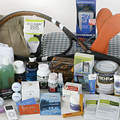 在過去8個月以來,奈米科技消費產品爆增了70%。評論家在認可這些先進分子科技價值的同時,也批評布希政府在確保奈米科技之於工作者及社會大眾的安全仍有很大的努力空間。伍德羅威爾遜國際學者中心(The Woodrow Wilson International Center for Scholars)在27日的報告中提到,目前已經有超過350種奈米科技消費產品上市,其中包括化妝品、防曬油、食品容器以及抗髒污的衣物產品等。
在過去8個月以來,奈米科技消費產品爆增了70%。評論家在認可這些先進分子科技價值的同時,也批評布希政府在確保奈米科技之於工作者及社會大眾的安全仍有很大的努力空間。伍德羅威爾遜國際學者中心(The Woodrow Wilson International Center for Scholars)在27日的報告中提到,目前已經有超過350種奈米科技消費產品上市,其中包括化妝品、防曬油、食品容器以及抗髒污的衣物產品等。
奈米科技是一種在原子或分子等級大小產生或改良材料,從而發展新的或強化的材料與產品。奈米材料只有十億分之一公尺的大小,比紅血球還要小上千倍。
由於奈米科技急速的發展,環保團體28日提出警告,美國環保署對於奈米相關產品的安全保障做得太少。美國自然保育委員會(The Natural Resources Defense Council)提到,對於奈米產品以及生產的製造商,其所可能產生的潛在健康以及環境威脅,我們所瞭解的並不多。
「含有未經測試以及分類的奈米微粒的日常生活用品產品,數量正急遽增加,但是環保署確保這些產品安全性的工作,卻進行得非常遲緩,」美國自然保育委員會研究員薩斯博士(Dr. Jennifer Sass)表示。「我們需要瞭解短期及長期的風險是甚麼,」她說,「尤其是我們已經開始穿著抗污染的衣物、應用奈米微粒製作的化妝品以及防曬乳液,並且使用添加奈米微粒的嬰兒溼紙巾來擦拭身體。」
伍德羅威爾遜中心新興奈米科技計畫的首席科學顧問梅納(Andrew Maynard),11月15日在《自然》期刊上刊出奈米科技所產生的一些風險。
梅納在文中提到,希望能號召瞭解奈米科技以及避免其風險更多更好的研究。「沒有策略性及目標性的風險研究,人們暴露在其所生產或使用的奈米物質下,可能引發意料之外的疾病。如果有真正或者預知的危險,人們對於奈米科技的信任度將會降低。而且由於害怕產生訴訟,也會降低投資者以及保險業者對奈米科技的興趣。」
不只有美國開始思考奈米科技的風險問題,27日,一份來自德國聯邦風險評估協會(Federal Institute for Risk Assessment)的消費調查報告顯示,消費者對於食物中添加奈米物質感到非常的不滿
The number of consumer products made with nanotechnology is exploding, with a 70 percent increase in the past eight months. While recognizing the value of these molecular-level advances, critics say the Bush administration is doing too little to ensure the safety of nanotechnology for workers and the public. The Woodrow Wilson International Center for Scholars said in a report Monday that more than 350 nanotech consumer products are now available, including cosmetics, sunscreens, food containers, and stain-resistant clothing.
Nanotechnology is the science of creating or modifying materials at the atomic and molecular level to develop new or enhanced materials and products. Nano-materials are one-billionth of a meter in size, a thousand times smaller than a red blood cell.
Considering the enormous growth of nanotechnology, an environmental group today warned that the U.S. Environmental Protection Agency is not doing enough to ensure safety. The Natural Resources Defense Council, NRDC, says not enough is known about potential health and environmental risks associated with nano-products and their manufacture.
"In the face of such a significant jump in the number of everyday products containing untested and unlabelled nanoparticles, the Environmental Protection Agency is moving much too slowly to ensure that they are safe," said Dr. Jennifer Sass, an NRDC staff scientist. "We need to know about the short and long-term risks," she said, "especially since we’re already wearing stain-resistant nanoparticle clothing, applying nanoparticle cosmetics and sunscreens, and swabbing our babies’ bottoms with nanoparticle baby wipes."
Andrew Maynard, chief science advisor for the Project on Emerging Nanotechnologies of the Woodrow Wilson Center outlined some of the risks of nanotechnology in a November 15 paper in the journal "Nature."
Calling for more and better research into understanding and preventing risk, Maynard wrote, "Without strategic and targeted risk research, people producing and using nanomaterials could develop unanticipated illness arising from their exposure; public confidence in nanotechnologies could be reduced through real or perceived dangers; and fears of litigation may make nanotechnologies less attractive to investors and the insurance industry."
The United States is not alone in its concern over the risks of nanotechnology. A consumer survey by Germany's Federal Institute for Risk Assessment, BfR, released Monday found that consumers were especially critical of the use of nanomaterials in foods.



